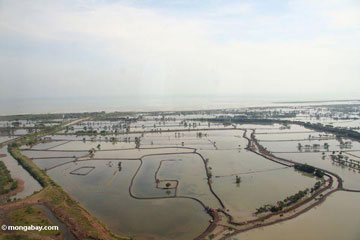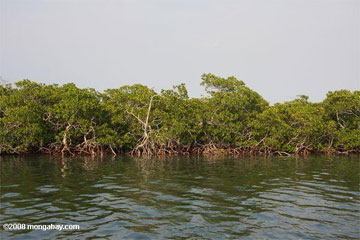How to replant a mangrove forest
How to replant a mangrove forest: local, low-cost initiatives prove most successful
Jeremy Hance, mongabay.com
July 23, 2008
|
|
Mangrove replanting and rehabilitation has become a widespread and important environmental initiative worldwide. Mangrove forests play key ecological roles, including sustaining fish populations and other wildlife, preventing erosion along coastlines, and acting as an overall carbon sink. Furthermore, mangroves have received attention lately for their role in providing an effective buffer against typhoons. In light of the many replanting initiatives now occurring, researchers J.H. Primavera and J.M.A. Esteban conducted a study of the overall effectiveness of different mangrove rehabilitation schemes. Their findings show that small, local, and generally cheaper initiatives have a higher success rate over large costly government and international programs.
The researchers chose the Philippines as their subject area. A nation of over 7,000 islands, the Philippines is a prime place for mangrove replanting, since the country has cut down over two-thirds of its mangroves in the past century. Most of this was due to fish and shrimp culture ponds, which now cover 232,000 hectares, compared with the 120,000 hectares of remaining mangroves.
 Mangroves cleared for agriculture and aquaculture |
Comparing eight different mangrove replanting initiatives in the Philippines, the authors found a lot of money was being spent on programs with low success rates: most initiatives showed only a 10-20 percent survival rate of planted mangroves. A World Bank project has spent 38 million on various coastal projects, including replanting mangroves, but despite the funds spent, their success rate—35 percent—was only slightly higher than average. Local programs with community-involvement have proven far more successful; one local government program reported a survival rate of 97 percent and spent a bargain-rate of just over 23,000 pounds ($45,000). Costs were cut and the survival rate raised, because adjacent communities invested time and energy into maintaining the mangroves.
A lack of knowledge also plagued larger initiatives. Sites that had never seen mangroves before were planted with poor success. A popular species, Rhizophora, was planted on sandy open coasts, in favor of two species more suited to that environment. Not being able to tolerate ocean waves, the trees did not survive.
 Healthy mangroves can help protect against storm surge and erosion |
A lack of political willpower has also proven paramount in the Philippines’ unsuccessful mangrove programs. Most of the suitable areas for mangroves are now culture ponds; some of these ponds are abandoned or underused, yet so far the government has failed lacked the political will to take-back such areas for mangrove cultivation. Instead, they continue to plant mangroves on seagrass beds and tidal flats where mangroves have never survived.
The authors believe that the Philippines is in ‘urgent need for immediate and massive mangrove replanting’. To create an effective barrier against typhoons and a stable environment, the authors suggest implementing a plan that would make the ratio of mangroves to culture ponds 4 to 1, where now culture ponds possess nearly double the land of mangroves. For a nation that sees 20-30 typhoons a year, mangroves could save lives and mitigate property damage. For example, in June of this year, the Philippines was hit by Typhoon Fengshen which destroyed over 50,000 homes, cost over 4.27 billion pesos, and killed 598 people.